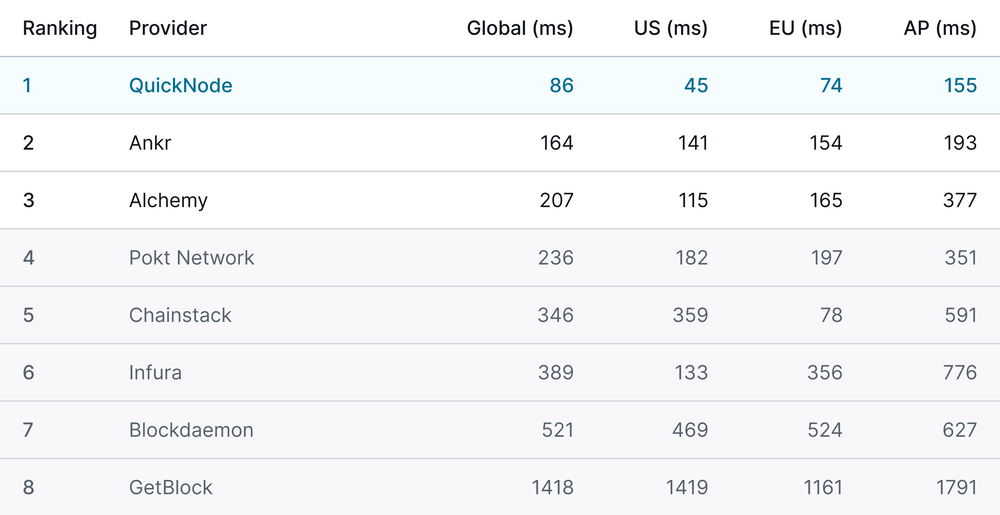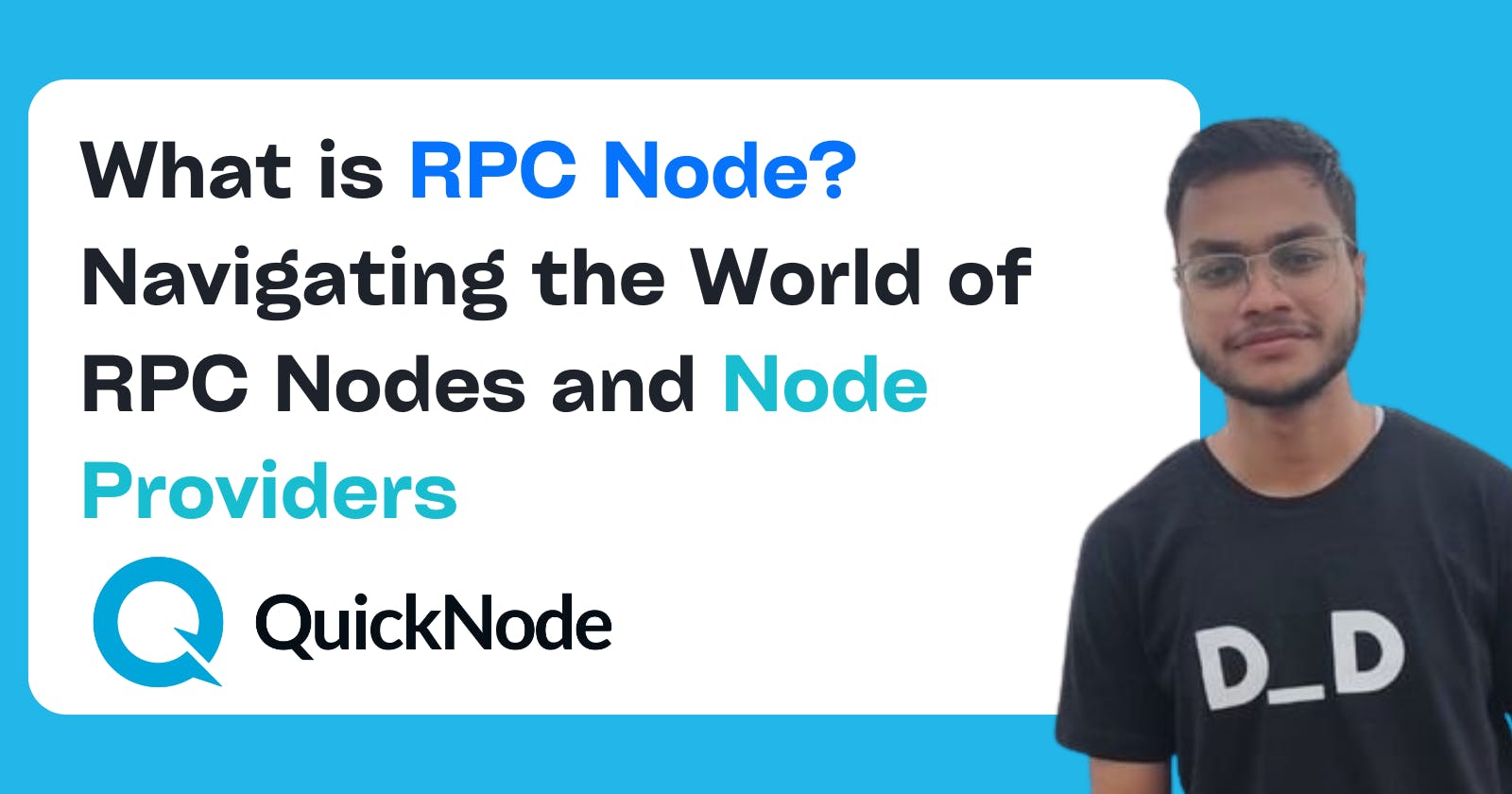What is RPC Node? Navigating the World of RPC Nodes and Node Providers
What is RPC Node? Why you should use RPC Node Providers? All about RPC Node and Node providers. Why you should use QuickNode as your Node Provider.
Table of contents
- What is an RPC node in blockchain?
- Use Cases For RPCs
- 1. Creating Decentralized Applications
- 2. Simplifying the Process of Building Dapps
- 3. Querying blockchain data
- 4. Run calls to retrieve vast amounts of data.
- 5. Developing WebSockets for Real-Time Transaction Data Viewing
- Why is running a node difficult?
- Setting up nodes can take a long time, sometimes up to weeks!
- Nodes have to be managed - by you!
- What is a Node Provider?
- Why you should use QuickNode as a Node Provider
- 🎉BOOM 🎉
If you're new to blockchain development, one question always arises: what is an RPC node? It is sometimes referred to as a Blockchain Node, Blockchain API Key, RPC URL, or Blockchain Endpoint. You may already know that RPCs are essential tools used by blockchain developers to build decentralized apps. But what exactly are they, and why are they so important in blockchain technology? In the following article, we will learn about this in detail. It will be a long article, but I assure you that if you stay with it, you will learn all you need to know about RPC nodes and node providers to get started as a web3 developer.
What is an RPC node in blockchain?
To begin, let's cover the fundamentals. An RPC node is a program that runs on a computer and facilitates connectivity with the broader blockchain network. It communicates with other nodes, exchanging information and verifying the validity of transactions between parties. Additionally, it stores crucial data regarding the current state of the blockchain.
RPC (Remote Procedure Call) is a type of API (Application Programming Interface) that enables developers to execute code on servers remotely. When developers build dApps that utilize RPC, the dApp can link user requests to information from blockchains. For instance, when users access an NFT collection, play a P2E game, or initiate transactions with MetaMask, the dApp leverages an RPC to connect them with nodes that hold blockchain data.
Finally, It's worth emphasizing that information on a blockchain can only be accessed via a node; there's simply no other way to do it. In many respects, an RPC node can be thought of as a browser for the blockchain, acting as a gateway between the user and the decentralized network of nodes that uphold the blockchain's integrity.

Use Cases For RPCs
1. Creating Decentralized Applications
RPC is widely used for developing dApps that can interact with one or multiple blockchains. Developers use RPC nodes to test and deploy smart contracts on networks. Decentralized applications are powered by smart contracts that enable functionalities like the automatic execution of crypto trades. They also offer user interfaces that make them accessible to a wide audience. The inclusion of an RPC layer in dApps allows these distinct software applications to communicate seamlessly with one another.
2. Simplifying the Process of Building Dapps
The RPC layer provides developers with a simplified approach to building decentralized applications. For example, if you were developing a DeFi liquidity farming site and wanted users to view their external wallet's crypto balance, you wouldn't need to create a wallet from scratch. Instead, you could build an API that can communicate with the external wallet to retrieve user holdings. Furthermore, the wallet software can include API-enabling code that facilitates interoperability with various other DeFi protocols.
3. Querying blockchain data
When building, developers also need access to a variety of information like block numbers, node connections, transactions, and historical blockchain data. They can make “requests” to their desired blockchain in JSON (JavaScript Object Notation) and receive replies with the info they need.
4. Run calls to retrieve vast amounts of data.
Developers can use RPC to execute tasks like encrypting wallets, creating multi-signature addresses, finding the current block size, producing human-readable JSON objects, and much more. These tasks provide critical information that builders need to create their blockchain platforms and services. With free, readily available, and reliable RPC access, developers can build faster and create more efficient applications.
5. Developing WebSockets for Real-Time Transaction Data Viewing
WebSockets are programming interfaces that enable continuous information exchange between a client and a server. By maintaining open and persistent communication, there is no need to establish a new connection for every message sent. They are particularly valuable for high-volume applications that require the transmission of substantial amounts of data, such as those found in Internet of Things (IoT) systems.
Now that you understand what RPC Node is and why we need it in Blockchain development. Let’s discuss how we can actually use or get RPC Node. We (Web3 developers) have two choices for accessing the node infrastructure necessary for building and operating dApps.
Running our own Node: Set up a node ourselves and take on the DevOps responsibility of equipment maintenance and server problem-solving, which is a very difficult task.
RPC Node Providers: Use services from RPC Node Providers like QuickNode via an RPC layer.
Why is running a node difficult?
There are a few things that make developing on your own node connected to the network particularly annoying. Let's discuss some reasons:
Setting up nodes can take a long time, sometimes up to weeks!
Developers often find it frustrating to spend significant time setting up a tool that does not directly add value to what they are trying to create and setting up nodes can be especially time-consuming and tedious.
There are typically two major categories of nodes
Light Nodes: sync just the block headers and requests from full nodes for many queries.
Full Nodes: Full nodes keep the entire state of a blockchain - every transaction that's ever been created
Although most queries can be handled by light nodes, full nodes are essential for serving most information and are the backbone of the blockchain. While light nodes have become relatively simpler in the past, they still require the installation of the node program, setting configuration variables, downloading block headers, and checking ports and health to ensure they're running correctly.
Full nodes are even worse as they require downloading every block from 0 to the latest one from scratch, and manually replaying every block and transaction ever submitted. For Ethereum mainnet, this amounts to over 10 million blocks and billions of transactions, which can take weeks to sync.
Nodes have to be managed - by you!
The biggest challenge to running your own node is that you have to manage it yourself, which can be a daunting DevOps project. Here's a quick summary of what's involved:
Nodes need to be upgraded regularly, typically every few weeks, and sometimes even rebuilt from scratch due to hard forks or node client upgrades.
Since most nodes were not designed with reliability in mind, certain queries (such as eth_getLogs) may require processing millions of blocks and transactions, often resulting in timeouts or node crashes.
Individual nodes can fall behind the network due to various issues, such as peering and connection problems, being stranded on outdated branches, or internal state problems. If your node falls behind, your users may be served stale data without realizing it, leading to a poor user experience. There are many other reasons why running your node can be time-consuming and unpleasant.
To save ourselves from all this unnecessary hard work, we can simply use RPC node providers. I understand that this article is lengthy, but please bear with me. You have already learned all about RPC nodes to get started. Now, let's learn about NODE PROVIDER.
What is a Node Provider?
In an ideal world, everyone would run their own node. Unfortunately, we don't live in an ideal world, which is why we have node providers. Node providers are essentially teams or companies (like QuickNode) that offer a way to access information on a blockchain without having to run your own node! Instead of sending your requests to a local node, you can send them over the internet to a provider offering an identical API that is running fully synced, up-to-date nodes available 24/7. A solid node provider will offer, at the very minimum:
Access to light and full nodes with regularly updated nodes and alerts so that you don't have to worry about forks or network changes.
Access to archive nodes for historical transaction data.
Scalability and reliability: nodes should be available whenever you want them and as much as you want them.
Consistency: Node Providers handle tricky edge cases.
In summary, you can access all the capabilities of an RPC node without any hassle by using node providers, but you will need to pay a fee for their services. By now, you have also understood the reasons why using node providers is preferable to running your own node.
Why you should use QuickNode as a Node Provider
QuickNode is an affordable, globally-distributed, multi-chain, multi-client, premium Web3 infrastructure provider. QuickNode powers industry leaders like Coinbase, 1inch, MagicEden, Exodus, and Nansen, to name a few and serves around 7 billion API requests per day (at the time of writing this article). Here's why businesses choose QuickNode for Web3 infrastructure!
Also, QuickNode is not only a node provider but an ecosystem in itself with a full suite of blockchain APIs — Core API, Token API, NFT API, Icy GraphQL NFT API — and the first of its kind, blockchain API Marketplace.
For Web3 to gain mass adoption, the UX needs to be pushed to the next level. And that could only happen with highly-performant applications powered by the finest infrastructure and service — nothing short of the best!

As evidenced by the data, we can conclude that QuickNode is the fastest and most stable node provider. QuickNode's motto is "do your stuff — build — and let us take care of the rest!" Here's Justifying Quick in QuickNode: A Response Time Comparison of Blockchain Node Providers! You can read this article to fully understand why QuickNode is the fastest.
🎉BOOM 🎉
You have completed the whole tutorial. Give yourself a big pat on the back. You have learned about:
What is RPC Node
Uses cases of RPC Node
Difficulties with running your own Node
Node Providers
Why you should use QuickNode
I hope you learned something new. Thanks for reading. Have fun!
You can follow me on Twitter, GitHub, and LinkedIn. Keep your suggestions and comments coming!
